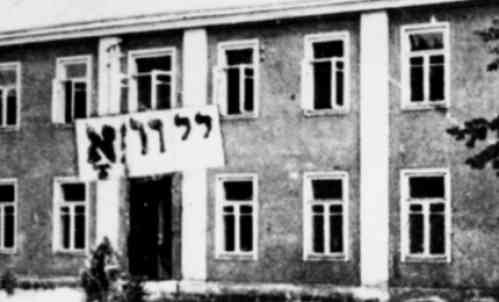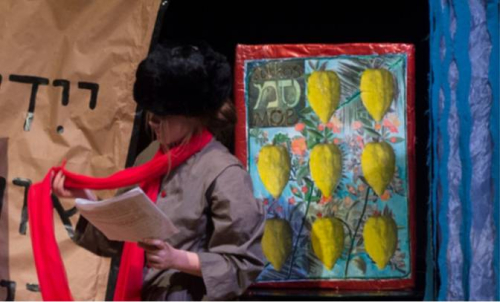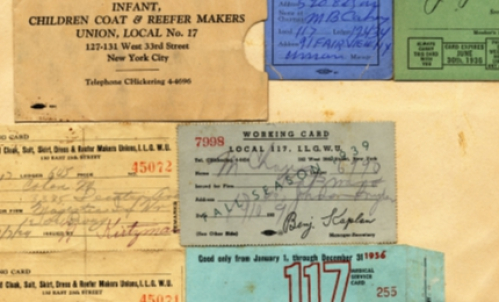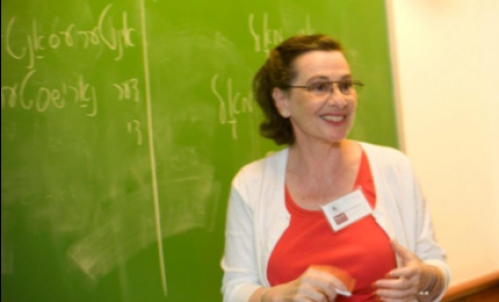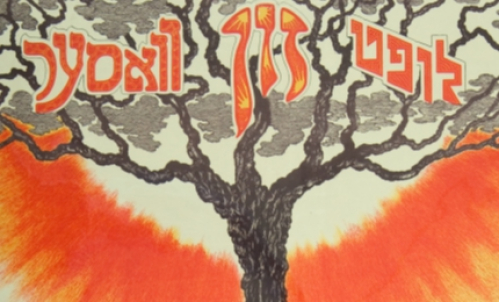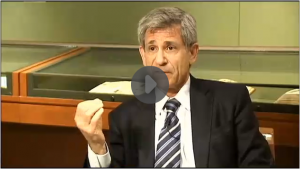Down with the “Revival”: Yiddish is a Living Language
by JENNIFER YOUNG
Let’s get one thing straight: Yiddish is not a dying language. While UNESCO officially classifies Yiddish as an “endangered” language in Europe, its status in New York is hardly in doubt. According to some estimates, Yiddish is the fifth most commonly spoken language in Brooklyn, behind English, Spanish, Russian, and Chinese. In the Brooklyn neighborhoods of Williamsburg and Boro Park alone, the number of Hasidic Jews, for whom Yiddish is the primary language, is well over 150,000. While census data on Yiddish is notoriously skewed (census numbers do not include speakers under 5 years of age, a major Hasidic demographic), the numbers indicate that Yiddish is here to stay: even UNESCO recently held a conference entitled, “The Permanence of Yiddish.”
News stories announcing the death, and/or rebirth, of Yiddish, abound in mainstream media today. The phrase “Yiddish revival” gets you 15,000 Google results, mostly recent articles from the Huffington Post, The New York Times, the Jerusalem Post, and Reuters, to name just a few from the top 10 hits. As one blogger has pointed out, Yiddish is “journalistic evergreen,” providing countless opportunities to recycle ideas about its demise, or (dramatic twist!) its rebirth. This week’s Atlantic article continues this trend: while posing the problem of Yiddish’s imminent demise, the article ends up underscoring the presence of important Yiddish cultural institutions, from YIVO’s own Yiddish-intensive summer program, to the Forverts, the Congress for Jewish Culture, the New Yiddish Repertory Theater, and Yugntruf.
If you are interested in Yiddish, you have probably received articles of this kind of from well-meaning relatives. Besides the death/revival duality, another motif common in this kind of reportage is the Hasidic/secular divide: this motif implies that, while Yiddish may have numbers on its side, Yiddish culture is still declining, because Hasidim don’t contribute to a modern, secular Yiddish culture. Along with the problematic assumption that Hasidim have nothing to contribute to the continuing vibrancy of modern Yiddish culture, one problem with these tropes is that they obscure a much more interesting cultural phenomenon: the way that Yiddish serves as a conduit for creating an overlapping space between the margins of both the secular and religious communities, allowing for a creative dynamism between the two.
Students of Yiddish know that the more you study the Yiddish language, the more you come to apprehend the immense breadth and depth of the Jewish experience—especially its religious aspects. We see examples of this every day at YIVO: newly religious Jews learn Yiddish in our classrooms to connect to their new communities, just as college students discover the Ba’al Shem Tov, the musar movement, and the proper time to daven shakhris within the stories of secular Yiddish writers like Sholem Aleichem and Chaim Grade. As a wider phenomenon, sociologists point to frum [religious] communities numerically strengthened by the addition of baalei teshuva (newly religious “returnees to the faith”), just as Yiddish cultural groups are strengthened by the presence of former (and sometimes current) Hasidim. This dynamic relationship speaks to the poly-lingual, multi-cultural ferment that constitutes contemporary yidishkayt.
While Yiddish is no longer the language of secular mass culture, its current “post-vernacular” status among non-Hasidic Jews means that the people who engage with Yiddish do so not as passive consumers, but as active builders of their own communities. As YIVO’s academic advisor, Eddy Portnoy, has remarked, while people have been proclaiming the death of Yiddish for over 200 years, the builders and kultur-tuers (cultural workers) of modern Yiddish culture have been blithely continuing on with their work. Ruth Wisse has noted that even when Yiddish was anchored in the demographic reality of millions of native speakers, it was “conceptually utopian” for its adherents to expect that Yiddish would function as a proxy for a “motherland.” Even at its apex, modern Yiddish culture fought back against decline—the pull of linguistic assimilation to Polish in Poland and English in North America was magnetic. Thus, the project of Yiddish culture has always been aspirational, relying on passionate convictions more than on steady funding and durable real estate.
So, if the “problem” with Yiddish really isn’t its constant near-death experience, then why all of this attention on its supposed revival? One answer is that American Jews born after World War II had to contend with a confusing haze of issues related to identity and belonging. Focusing on Hebrew culture and literacy, promoting Jewish identity in relationship to the newly-emerged state of Israel, and working to achieve economic security and social acceptance all contributed to the marginalization of Yiddish language and culture as a conduit of a living, historically-connected Jewish way of life.
As baby boomers came of age, leaders of the next generation of Yiddish teachers, scholars, and performers emerged; people like David Roskies, Ruth Wisse, Adrienne Cooper, Lorin Sklamberg, Josh Waletzky, Jenny Romaine, and Henry Sapoznik came to YIVO and learned and worked alongside bearers of the interwar legacy, like Max Weinreich, Dina Abramowicz, Lucjan Dobroszycki, Beyle Schaechter-Gottesman and Mordkhe Schaechter. This inter-generational connection was, and still is, a crucial part of the ongoing transmission of Yiddish cultural knowledge. By founding and/or leading institutions like Klezkamp and Yugntruf, establishing bands like Kapelye and the Klezmatics, and training new generations of students and teachers right here in the YIVO summer program, these continuities may have looked from the outside like a revival—but to those doing the work, the object was not reconstruction but renewal from within.
Rokhl Kafrissen, a Yiddish cultural critic who just premiered a new bilingual English-Yiddish play at Klezkanada, has blogged extensively about the deep proliferation of “Yiddish death/revival” memes. She summed up her perspective concisely in a 2012 year-end summary of Yiddish in the popular press:
“…[T]here is no revival. There is only a Jewish populace deeply confused about its identity and conflicted about the sacrifices it's made in the name of assimilation, Americanization, Zionism and the myth of a unified Jewish monoculture…”
As Rokhl points out, the “revival meme” contributes to the ongoing “neutralization” of Yiddish as something “cute, unthreatening, and incapable of maturing.” It is, ultimately, a demeaning and politicized way of approaching a significant and sensitive subject like Jewish cultural continuity.
Like many of my friends and colleagues, I learned Yiddish not from home but from school-in my case, at McGill University and in the YIVO summer program (a sheynem dank, Anna Gonshor, Eugene Orenstein and Sheva Zucker!). Places like YIVO prove that you don’t need to be born a native speaker, or to grow up to be a Yiddish professor to contribute to Yiddish continuity. There are a wealth of Yiddish cultural institutions and Yiddish-speaking communities—YIVO, Yidish-Vokh, Yiddish Farm, Klezkamp and Klezkanada, to name just a few I’ve been a part of—that make Yiddish cultural continuity their mission. They do this by being welcome to everyone, and by providing not only awe-inspiring teachers, mentors, and communal leaders, but also by providing the opportunity to forge life-long connections, friendships, and communal bonds.
It is for the sake of these larger goals that it is worth trying to move beyond the discussion of the Yiddish “revival,” and to instead insist on talking about Yiddish as a living language and culture. The journalists who continue to “discover” the Yiddish revival year after year are certainly well-intentioned, but the overall effect of their stories is ultimately pernicious: until we can address Yiddish on its own terms and begin a new conversation without cliches, we will continue to lose ground.
To quote from the liner notes of the late, beloved Adrienne Cooper’s CD, Dreaming in Yiddish:
"The linguist Max Weinreich wrote that Yiddish is the language of the Jewish unconscious in which every modern Jew will eventually dream. When that Yiddish dream comes to them, they will need interpreters. These interpreters embrace Yiddish as self-expression, for its hard-to-describe delights, for the rage it brings to injustice, for its wonderful weight on the tongue, for the spectacular arc it forms between poles of Jewish identity…”
As a global community of people who care about Yiddish, and within our own Jewish institutions, we need to take control of framing the narrative of Yiddish as an integral, dynamic, and healthy part of Jewish life—neither cute nor fragile, neither hip nor "schmaltzy."
Watch a Fox News feature on Yiddish at YIVO.
